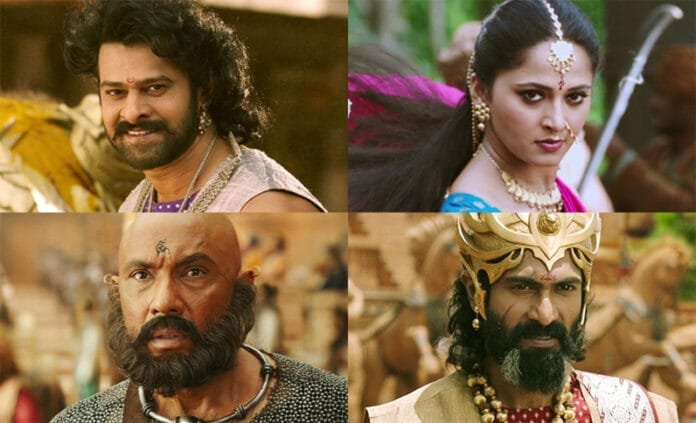10 years ago, on July 10, 2015, Indian cinema witnessed a seismic shift with the release of ‘Baahubali: The Beginning’—a film that redefined scale, ambition, and visual grandeur. Directed by SS Rajamouli and starring Prabhas, Anushka Shetty, Rana Daggubati, and Sathyaraj, this epic didn’t just break box office records—it forged a legacy. As the film celebrates a glorious decade, we unveil some of the most fascinating, funny, and lesser-known stories from its journey.
The Mystery That Gripped a Nation: Why Did Kattappa Kill Baahubali?
No Indian film in recent memory sparked as much curiosity as this one question. The cliffhanger—“Why did Kattappa kill Baahubali?”—was a masterstroke. Even Sathyaraj, who portrayed Kattappa, and Prabhas were kept in the dark. Director Rajamouli maintained a tight veil of secrecy on the twist to ensure that even the cast couldn’t leak the plot. This enigma led to two years of fan theories, memes, and national anticipation.
Prabhas’ Ultimate Sacrifice: Five Years, One Role
Most actors juggle multiple films a year. But Prabhas chose a different path. He dedicated five full years exclusively to Baahubali, refusing all other roles. He transformed his physique, trained rigorously in martial arts, archery, and horse riding, and lived the character both on and off the screen. This level of commitment is virtually unheard of in Indian cinema.
Rana Daggubati’s Hidden Struggle: Vision in One Eye
The powerful Bhallaladeva, played by Rana Daggubati, is one of the most intimidating villains in Indian film history. What most people don’t know is that Rana is blind in one eye. Born with this condition, he once confessed, “If I close my left eye, I see nothing.” Yet, he never let this impairment hinder his performance. His portrayal was so fierce that fans never suspected his condition.
Armoured for Glory: Real Metal, 30 Kilos of Grit
The authenticity of Baahubali’s battle sequences owes much to the real metal armour the actors wore. Prabhas’s costume alone weighed 30 kilograms. The heavy swords and shields weren’t props—they were forged to feel authentic. Despite the weight, not once did Prabhas or the others complain. They fought, ran, and emoted under the burden, ensuring visual realism unmatched by CGI-heavy films.
Vijayendra Prasad’s Mythical Blueprint: A Father’s Epic Vision
Behind every masterpiece is a master storyteller. Vijayendra Prasad, father of SS Rajamouli, penned the story of Baahubali, inspired by Mahabharata and Ramayana. Originally conceived as a novel, this rich narrative was filled with royal drama, sibling rivalry, honor, betrayal, and sacrifice. Rajamouli then transformed his father’s vision into one of the grandest cinematic spectacles ever created.
The Mahishmati Empire: 300 Artists, 200 Days
The magical kingdom of Mahishmati was not a result of computer graphics alone. Over 300 artisans worked for 200 consecutive days to create this world. Every palace, corridor, and battleground was meticulously hand-built. The visual splendor we witnessed was as real as it gets, crafted with detail and devotion that rivaled historic monuments.
The Most Expensive South Indian Film of Its Time
With a production budget of ₹180 crore, ‘Baahubali: The Beginning’ was the costliest South Indian movie ever at that time. Its VFX budget alone touched ₹85 crore. From towering waterfalls to vast armies and gigantic creatures, every frame was a visual treat. The return? A worldwide box office storm that more than justified the gamble.
Watermelons in Action: The Spear Scene Secret
Remember the spine-chilling spear-throwing sequence by Baahubali? To perfect the physics and camera angles, the VFX team used watermelons to test the scene. The fruit mimicked the density of human flesh, helping designers understand how a spear would pierce, rotate, and exit. The end result? A shot so realistic that audiences gasped.
Kattappa Was Almost Mohanlal
Veteran Malayalam superstar Mohanlal was originally considered for the role of Kattappa. However, due to schedule conflicts, he declined the role. Enter Sathyaraj, who immortalized the character. His loyalty, pain, and internal conflict became central to the film’s soul, making Kattappa one of Indian cinema’s most iconic characters.
Netflix’s Lost Prequel: ‘Before the Beginning’
Seeing the explosive popularity of the franchise, Netflix commissioned a prequel series titled ‘Baahubali: Before the Beginning’. It was meant to explore the early days of Shivagami and the origins of Mahishmati. Despite massive investments and casting, the show faced technical hurdles and production delays, and was eventually shelved. Even without it, Baahubali’s empire reigns.
Anushka Shetty’s Shivagami: Power Redefined
Though Anushka Shetty played Devasena, it was Ramya Krishnan as Shivagami who left an unforgettable impact. Her portrayal of the fierce queen who balances love, justice, and statecraft was a cinematic tour de force. The throne room scene where she declares “Amarendra Baahubali will be the king” remains etched in cinematic history.
Baahubali’s Cultural Impact: From Fan Tattoos to Museums
Baahubali’s influence extended beyond screens. Fans tattooed Baahubali symbols, fan art flooded social media, and merchandise sold in millions. Several film schools introduced Baahubali case studies to teach visual storytelling and brand-building. In Hyderabad, props and set pieces were displayed in exhibitions attended by thousands.
Dubbed in Over 10 Languages: A Pan-India Phenomenon
Initially made in Telugu, Baahubali was dubbed in Hindi, Tamil, Malayalam, Kannada, Japanese, Russian, and more. The Hindi version became a massive hit, outperforming many Bollywood films. It marked a turning point, showing that regional films could dominate national and international markets.
Global Awards and International Applause
Baahubali earned accolades globally. It won National Film Awards, broke viewership records in Japan, and was screened at film festivals in France, Russia, and China. It was one of the first Indian films to trend on Netflix US, further cementing its worldwide impact.
10 Years Later: Baahubali’s Unshakable Legacy
Today, Baahubali stands as a cultural milestone. It changed the way Indian films are made, marketed, and consumed. Its bold storytelling, impeccable performances, breathtaking visuals, and visionary direction remain unmatched. As we celebrate 10 years, Baahubali isn’t just a film—it’s a movement, an emotion, and a standard that raised Indian cinema to global prominence.
















